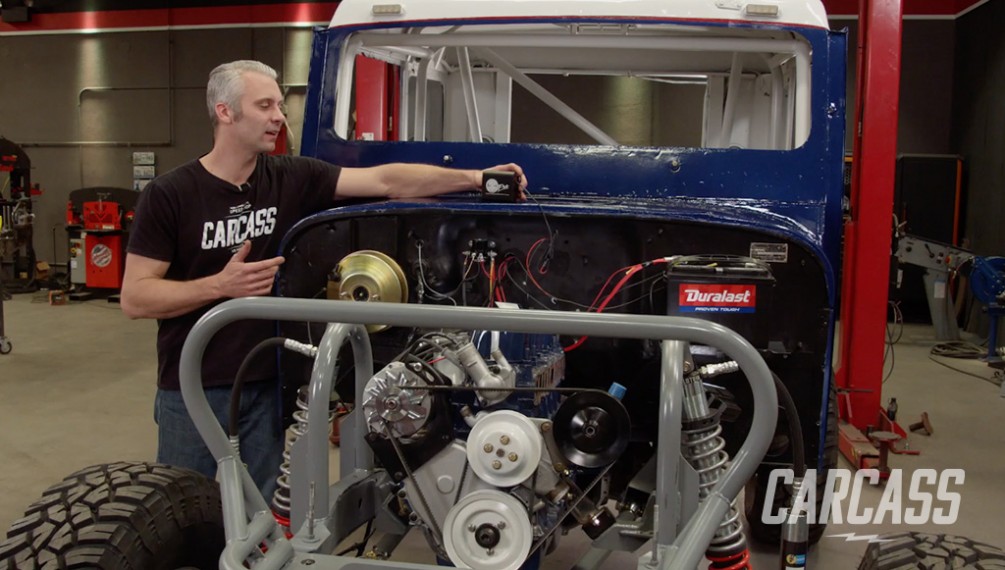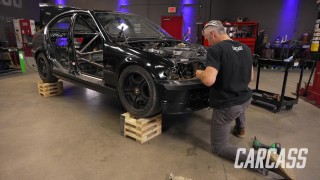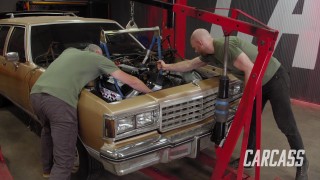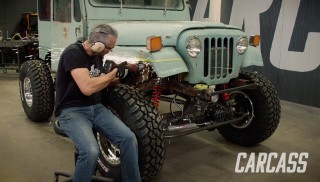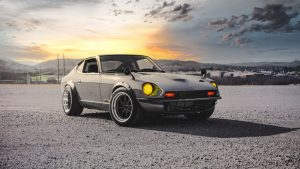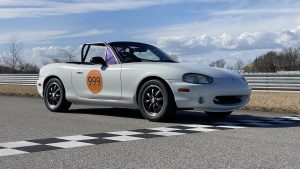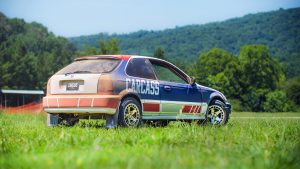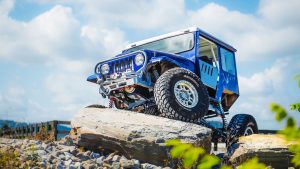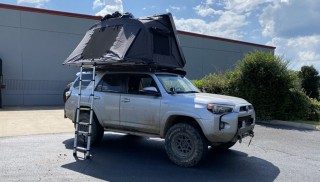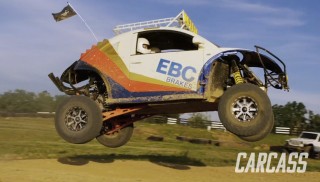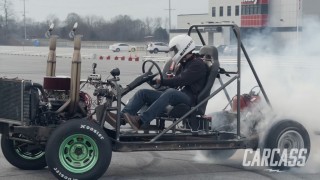More Junk Mail DJ5 Episodes
Carcass Featured Projects
Carcass Builds
Want more content like this?
Join the PowerNation Email NewsletterParts Used In This Episode
ARP
Bolts & Fasteners
Duralast
Duralast Alternator
Duralast
Duralast Battery
Duralast
Duralast Starter
Matco Tools
MATCO Tools are the Official Tool Supplier to Carcass
The Industrial Depot
Tools, Hardware, Shop Supplies
Episode Transcript
(Jeremy)>> You're watching Powernation!
(Jimmy)>> Today on Carcass it's been a long road but we finally start putting Junk Mail back together. We take care of all the wiring and ignition to give it some spark.
(Jeremy)>> We add a few components to help our engine and transmission stay cool. Then finish up our fuel system and exhaust getting our DJ-5 Jeep ready to fire for the first time. [ MUSIC ] [ tires squealing ] [ MUSIC ] [ engine revving ] [ MUSIC ]
(Jeremy)>> Hey everybody, welcome to Carcass!
(Jimmy)>> We put a ton of time into our Jeep making it something that's off road worthy, and that's a far cry from what it used to be, a two wheel drive US postal Jeep. It all started with us wanting to do a right hand drive project, and we came across three US postal Jeeps for sale. So we bought all three and brought them back to the shop. After choosing which one was the best one we started tearing it apart to make room for some upgrades. We cleaned up the old frame removing the old leaf springs and mounts. Then we went to a salvage yard and grabbed a set of one ton axles, and after cleaning them up we added new gears and lockers, making our axles pretty much bombproof, and we also fabricated a four link suspension with some good coil over shocks.
(Jeremy)>> Next we dropped in a drivetrain and added a four to one transfer case making our Jeep four wheel drive. After dropping the body back on we made a few modifications to make room for our off road chassis. The interior got an overhaul as well adding a roll cage for safety. With all that done it was time to take it all apart and start prepping the body and chassis for some paint. For our paint we went with a familiar theme common to US postal vehicles. The old red, white, and blue. As for our chassis we finished welding all of our suspension brackets and gave it a quick cleaning. To protect all of our work we hit it with a fresh coat of paint, and that brings us to how Junk Mail is sitting right now, and we've got a ton of stuff we want to take care of today cause we want to get this thing fired up. We've got an entire fuel system to run, a cooling system to plumb in, and a mess of wiring to straighten out, and that's exactly where we're gonna start. Now on the wiring side we're gonna be doing some of the basics. We're gonna be installing a new starter and a new alternator, but on the ignition side we went to Holley Performance and picked up an MSD Digital-6 off road box. This is fully potted. So it can withstand high vibrations and wet conditions. It'll give us crisp, clean throttle response at low r-p-m, which is great for rock crawling, and it's selectable between four, six, and eight cylinders, and since our Jeep's got that iconic six cylinder in it this thing's gonna work perfect. Now what I've got to do is just figure out where I'm gonna put this thing. Over at the Jeep we've got a couple of options where we can mount the box. We can either put it outside in the engine compartment or we've got a better solution. We can come inside here, set it up on the firewall. That way we can read the display and make adjustments if we have to. Once we have our location I'll mark our holes using a punch and drill them out. [ drill humming ]
(Jeremy)>> Then we can add our mounting hardware and screw it into place. [ MUSIC ] Using a hole saw I'll drill out the firewall making room for our wiring harness. [ MUSIC ] And plug in our connections. [ MUSIC ] Next I'll drop in our Duralast starter. It's an o-e-m replacement and bolts right in. [ MUSIC ] For our charging system we're gonna be bolting up a Duralast alternator that we got from AutoZone, and it bolts right onto the stock bracket. [ MUSIC ] With that in place we can add our new belt and tighten everything up. [ MUSIC ] Another thing we wanted to install was a new set of gauges cause we want to make sure we watch all the vital signs of our newly rebuilt engine. The gauges we got are super easy to install and fit perfectly into the existing holes in our dash. [ MUSIC ] I'll feed the temp sensor through the hole in our firewall we made earlier and screw it into our freshened up engine. To finish up our electrical I'll drop in a new Duralast battery. Then we'll bolt up our starter solenoid... [ MUSIC ] ...and connect all of our wiring. [ MUSIC ] With the wiring done in our Jeep it's time to protect it. Now we noticed when we picked our Jeep up out of the field that it had shown signs of mice and rodents inside nesting, and wiring is one of these most important parts of your vehicle, and if it's gonna be sitting for a long time mice can become an issue. Well to protect your wiring you guys may want to check out Mouse Blocker Pro. This little box right here emits an ultra high frequency that deters mice and rodents from nesting inside your vehicle. It's got three power settings and dual strobing l-e-d's for added protection. It's also got a built in micro processor that checks your battery and automatically shuts off if the voltage gets below 11 volts. It's simple to install with just a couple of wires connected to your battery. Now if you guys want more information whey don't you check out Mouse Block dot com. When out on the trails you want to keep everything cool. We make a few modifications to accommodate a new radiator and a trans cooler.
(Jimmy)>> Now it's time to start on our cooling system. We're going with this aftermarket aluminum radiator we got from Summit Racing. It's very similar in size with the inlet and outlet locations close to the original radiator. We're doing this because we didn't have any luck finding a stock radiator for a DJ-5, and the two radiators we had from our parts Jeeps were in really poor shape, but mounting something like this doesn't come without its own set of issues. So we've got to try to sink this thing into the grille shell and that's where we're gonna start. Using a scribe I'll make a few marks where I need to make my cut. To make this cut I'll be using a cutoff wheel, being very careful to follow my mark as close as possible. [ saw buzzing ]
(Jimmy)>> Once it's cut we drop in our new radiator and mark our new mounting holes. I've got to mark and drill right there, and right here. Now we can drill the holes. [ drill humming ]
(Jimmy)>> Then I'll measure. That's one and three quarter offset. [ mechanical humming ]
(Jimmy)>> Cut! [ mechanical humming ]
(Jimmy)>> Bend! [ mechanical humming ] [ MUSIC ]
(Jimmy)>> Drill a few holes. [ drill humming ]
(Jimmy)>> And mount our new brackets. [ MUSIC ] Now that I know our brackets work there's one more thing I have to take care. Because the radiator is pushed into the grille shell the filler neck is kinda shrouded by the grille shell itself. So we have to make some clearance for it, and what I'm gonna do is take some tape and put it on the paint to protect it, and then I'm gonna use a hole saw to cut it out. [ MUSIC ] [ saw buzzing ] [ MUSIC ] [ saw buzzing ]
(Jimmy)>> With our hole finished I'll clean it up with a cutoff wheel and make our edges smooth using a flap wheel. [ grinder buzzing ]
(Jimmy)>> Now we're ready to pull off the tape and install our radiator for the final time. [ MUSIC ] Put it in for the last time. Oh yeah! [ MUSIC ] We've got our cooling system pretty much wrapped up. The only thing I still have to do is loop the heater hose inlet and outlet, and then put some coolant in it when it comes time to fire this thing up.
(Jeremy)>> With Jimmy having the cooling system buttoned up underneath the hood there is one more thing that we want to keep cool and that's our transmission. Now with low speed driving and rock crawling transmissions have a tendency of heating up. So we went to Summit Racing and picked up a stand alone transmission cooler. We're running out of room underneath the hood to put this thing. So we've got to come up with a different solution, and I think I know exactly where I want to put it, and that's underneath the truck. Underneath our Jeep we have two crossmembers that this lands on almost perfectly. It puts the cooler out of the way of the suspension travel, and it'll be a quick run for the cool lines up to the transmission. I'll hold it in place using some locking pliers. Then we can drill out our holes. [ drill humming ]
(Jeremy)>> And bolt it up to the chassis. Once secure I'll hook up our lines to our cooler as well as our transmission. [ MUSIC ] Right as rain.
(Jimmy)>> If it doesn't run we can't have any fun. We tackle our fuel system to get Junk Mail ready to breathe again.
(Jeremy)>> With the wiring and the cooling system taken care of there are a couple of things we have to do before we can fire up the Jeep, and one of those is the fuel system.
(Jimmy)>> And part of that is the fuel cell. The stock tank in this Jeep was up under the cab but because of our axle and suspension it's not gonna fit. So we're gonna put it behind the seats in the cab.
(Jeremy)>> And the other half of that is underneath the hood. So I'm gonna be working on the intake and the exhaust manifold. We'll slap a carburetor on top of that and we'll start running some fuel lines.
(Jimmy)>> For our fuel system we're going with an RCI 15 gallon aluminum fuel cell that we got from Summit Racing, and to get the fuel to the front we've got Earl's Vapor Guard hose, and to feed our six cylinder engine we have a 450 c-f-m carburetor from Quick Fuel Technologies. To get this whole thing started I've got to find a way to mount the fuel cell. To mount the fuel cell I'm gonna run a couple of straps from this cover over the top of the tank around to the floor and I'll secure it with a couple of screws. I'm gonna make these out of aluminum to try to change it up a little bit. So all I really have to do is measure, bend straps, and drill a couple of holes. [ MUSIC ] Nine and a half. [ MUSIC ] With our measurements in the aluminum straps marked I'll head over to the band saw and cut them out. [ saw buzzing ] [ MUSIC ]
(Jimmy)>> Using a break I'll make sure our straps are square and make a few 90 degree bends. [ MUSIC ] Now it's time to drill out our holes. [ drill buzzing ]
(Jimmy)>> I'll round off the edges over at the belt sander. [ sander buzzing ]
(Jimmy)>> With that done we can install them in our Jeep. [ drill humming ]
(Jimmy)>> To make it easier to locate the screws I'll drill a few pilot holes and attach it using some self tapping screws and a piece of foam to help keep tension on the strap. [ MUSIC ] [ drill humming ]
(Jimmy)>> With our fuel cell installed I have just a couple of things left to do. I'm gonna drill a couple of holes in this panel and install some grommets. Then I'm gonna run one line out the back for a vent and run the other line up to the front for the fuel pump. [ MUSIC ]
(Jimmy)>> To make our holes I'm using a one and a quarter inch hole saw. [ drill humming ]
(Jimmy)>> With our holes cut I can add our grommets, install the fuel hose, and tighten it down. [ MUSIC ] Now I can run the hose from our tank up to the engine bay. Alright now the last thing, replace the old fuel pump with a new one. Our old fuel pump would probably work but since we have a fresh engine and all new parts it's a good idea to go ahead and update this as well. [ MUSIC ] Before installing our new pump I need to remove what's left of the old gasket using a razor blade. With our new pump ready to install I'll add a new gasket. It's also a good idea to add some gasket maker to the engine block to make sure we don't have any oil leak. Now we can install our new fuel pump and bolt it down. [ MUSIC ] Last thing I need to do is install the fuel hose from our tank and tighten it.
(Jeremy)>> With Jimmy taking care of the fuel system in the back I'm gonna start in the engine bay. Now the intake and exhaust manifold share the same mounting points on the cylinder head. So we have to put them on in pairs. What I'm gonna start with is a fresh gasket. Then we'll bolt up the exhaust manifold with a couple of bolts and we'll move on to the intake. [ MUSIC ] Before we install our intake we're gonna add a little gasket maker to make sure our seal is nice and tight. Alright all bolted up. [ MUSIC ] With the intake and exhaust manifold on we'll add our ARP bolts and grab our torque wrench to tighten them up. We're using our Matco Tools three-eighths drive fixed end electronic torque wrench. It's easy to use and simple to setup. [ beep ]
(Jeremy)>> Just dial in your setting. For us we need 23 foot pounds. It has four torque alert modes and an l-c-d display. So when you land on your torque spec the l-e-d changes, you hear a beep, and the handle vibrates. It only needs of swing to grab the next tooth, and it's fully programmable. It also has an angle feature for those times when you need to add a degree of rotation to your bolt after you reach your torque spec. With our intake on we'll add a gasket and a spacer. Alright let's throw this carburetor on here. With our carburetor installed I'll go ahead and snug it down. [ MUSIC ] The fuel lines go on next and get fastened. [ MUSIC ] With our hoses attached to the carb we can now run our new lines over to the pump that Jimmy installed. [ MUSIC ] Alright well that takes care of the fuel system. There's still a couple more things underneath the hood we've got to take care of before we fire this thing up. We built a custom exhaust. Then it's time to light the fires on Junk Mail.
(Jimmy)>> We're getting really close. I'm gonna go grab a couple more parts so we can finish it.
(Jeremy)>> With the wiring, the fuel, and the cooling system taken care of we're almost ready to fire up project Junk Mail but there is one more thing we have to do and that's the exhaust. Now we can't run a traditional exhaust system underneath the Jeep because our upper four link bars are in the way but we do have a solution. The plan is to run our exhaust out the passenger side and then we'll just end it underneath the floor board. Now there is one piece I do have to make and that's down here on the manifold. To make our exhaust I have to flare one end to match the bevel on our manifold. Now that's about 45 degrees. So I'm gonna grab some tubing and head over to the machine. Using a piece of two inch tube I'll use a female ball socket to match the taper of our exhaust manifold, followed by a flare flange to finish it up. [ MUSIC ] Since we have a tight turn I'll need to cut it. Yep, that fits perfectly. To finish the down pipe I'll grab another piece of two inch tube that has a 90 degree bend in it and swage one end to step it up to two and a quarter inches. [ MUSIC ] I'll take the pieces over to the table and tig them together. [ MUSIC ] Alright, now we'll just throw this 45 on here. That gets us under the floor. Then we'll just add a muffler. With our down pipe in place I'll tack in our 45 for the muffler and the exhaust tip. Now we'll just take it off, weld it up on the table. To finish welding our exhaust I'll be using the mig welder. [ welder crackling ] [ MUSIC ]
(Jeremy)>> Alright let's get this thing in here so we can fire this thing up. [ MUSIC ]
(Jimmy)>> At this point our exhaust is all wrapped up and looking real nice. So now all I've got to do is top off the fluids like fuel, power steering, transmission, and coolant before firing up Junk Mail for the first time. [ MUSIC ]
(Jeremy)>> Okay all the fluids are in it. We did prime it a little bit cause we've got fuel pressure. I think it should start right up.
(Jimmy)>> Let's hear it.
(Jeremy)>> Here we go! [ engine starting & revving ]
(Jeremy)>> It's got a good sound. We're super close to hitting the trails now. We still have some stuff to do. We've got brakes to do, driveshaft, and we've still got to button up all the interior.
(Jimmy)>> But that's it for this episode. So if you like anything that you've seen go to Powernation TV dot com. Fire this thing up and we'll check a-t-f.
(Jeremy)>> We'll check that one more time. [ engine starting ]
(Jeremy)>> It does run good.
Show Full Transcript
(Jimmy)>> Today on Carcass it's been a long road but we finally start putting Junk Mail back together. We take care of all the wiring and ignition to give it some spark.
(Jeremy)>> We add a few components to help our engine and transmission stay cool. Then finish up our fuel system and exhaust getting our DJ-5 Jeep ready to fire for the first time. [ MUSIC ] [ tires squealing ] [ MUSIC ] [ engine revving ] [ MUSIC ]
(Jeremy)>> Hey everybody, welcome to Carcass!
(Jimmy)>> We put a ton of time into our Jeep making it something that's off road worthy, and that's a far cry from what it used to be, a two wheel drive US postal Jeep. It all started with us wanting to do a right hand drive project, and we came across three US postal Jeeps for sale. So we bought all three and brought them back to the shop. After choosing which one was the best one we started tearing it apart to make room for some upgrades. We cleaned up the old frame removing the old leaf springs and mounts. Then we went to a salvage yard and grabbed a set of one ton axles, and after cleaning them up we added new gears and lockers, making our axles pretty much bombproof, and we also fabricated a four link suspension with some good coil over shocks.
(Jeremy)>> Next we dropped in a drivetrain and added a four to one transfer case making our Jeep four wheel drive. After dropping the body back on we made a few modifications to make room for our off road chassis. The interior got an overhaul as well adding a roll cage for safety. With all that done it was time to take it all apart and start prepping the body and chassis for some paint. For our paint we went with a familiar theme common to US postal vehicles. The old red, white, and blue. As for our chassis we finished welding all of our suspension brackets and gave it a quick cleaning. To protect all of our work we hit it with a fresh coat of paint, and that brings us to how Junk Mail is sitting right now, and we've got a ton of stuff we want to take care of today cause we want to get this thing fired up. We've got an entire fuel system to run, a cooling system to plumb in, and a mess of wiring to straighten out, and that's exactly where we're gonna start. Now on the wiring side we're gonna be doing some of the basics. We're gonna be installing a new starter and a new alternator, but on the ignition side we went to Holley Performance and picked up an MSD Digital-6 off road box. This is fully potted. So it can withstand high vibrations and wet conditions. It'll give us crisp, clean throttle response at low r-p-m, which is great for rock crawling, and it's selectable between four, six, and eight cylinders, and since our Jeep's got that iconic six cylinder in it this thing's gonna work perfect. Now what I've got to do is just figure out where I'm gonna put this thing. Over at the Jeep we've got a couple of options where we can mount the box. We can either put it outside in the engine compartment or we've got a better solution. We can come inside here, set it up on the firewall. That way we can read the display and make adjustments if we have to. Once we have our location I'll mark our holes using a punch and drill them out. [ drill humming ]
(Jeremy)>> Then we can add our mounting hardware and screw it into place. [ MUSIC ] Using a hole saw I'll drill out the firewall making room for our wiring harness. [ MUSIC ] And plug in our connections. [ MUSIC ] Next I'll drop in our Duralast starter. It's an o-e-m replacement and bolts right in. [ MUSIC ] For our charging system we're gonna be bolting up a Duralast alternator that we got from AutoZone, and it bolts right onto the stock bracket. [ MUSIC ] With that in place we can add our new belt and tighten everything up. [ MUSIC ] Another thing we wanted to install was a new set of gauges cause we want to make sure we watch all the vital signs of our newly rebuilt engine. The gauges we got are super easy to install and fit perfectly into the existing holes in our dash. [ MUSIC ] I'll feed the temp sensor through the hole in our firewall we made earlier and screw it into our freshened up engine. To finish up our electrical I'll drop in a new Duralast battery. Then we'll bolt up our starter solenoid... [ MUSIC ] ...and connect all of our wiring. [ MUSIC ] With the wiring done in our Jeep it's time to protect it. Now we noticed when we picked our Jeep up out of the field that it had shown signs of mice and rodents inside nesting, and wiring is one of these most important parts of your vehicle, and if it's gonna be sitting for a long time mice can become an issue. Well to protect your wiring you guys may want to check out Mouse Blocker Pro. This little box right here emits an ultra high frequency that deters mice and rodents from nesting inside your vehicle. It's got three power settings and dual strobing l-e-d's for added protection. It's also got a built in micro processor that checks your battery and automatically shuts off if the voltage gets below 11 volts. It's simple to install with just a couple of wires connected to your battery. Now if you guys want more information whey don't you check out Mouse Block dot com. When out on the trails you want to keep everything cool. We make a few modifications to accommodate a new radiator and a trans cooler.
(Jimmy)>> Now it's time to start on our cooling system. We're going with this aftermarket aluminum radiator we got from Summit Racing. It's very similar in size with the inlet and outlet locations close to the original radiator. We're doing this because we didn't have any luck finding a stock radiator for a DJ-5, and the two radiators we had from our parts Jeeps were in really poor shape, but mounting something like this doesn't come without its own set of issues. So we've got to try to sink this thing into the grille shell and that's where we're gonna start. Using a scribe I'll make a few marks where I need to make my cut. To make this cut I'll be using a cutoff wheel, being very careful to follow my mark as close as possible. [ saw buzzing ]
(Jimmy)>> Once it's cut we drop in our new radiator and mark our new mounting holes. I've got to mark and drill right there, and right here. Now we can drill the holes. [ drill humming ]
(Jimmy)>> Then I'll measure. That's one and three quarter offset. [ mechanical humming ]
(Jimmy)>> Cut! [ mechanical humming ]
(Jimmy)>> Bend! [ mechanical humming ] [ MUSIC ]
(Jimmy)>> Drill a few holes. [ drill humming ]
(Jimmy)>> And mount our new brackets. [ MUSIC ] Now that I know our brackets work there's one more thing I have to take care. Because the radiator is pushed into the grille shell the filler neck is kinda shrouded by the grille shell itself. So we have to make some clearance for it, and what I'm gonna do is take some tape and put it on the paint to protect it, and then I'm gonna use a hole saw to cut it out. [ MUSIC ] [ saw buzzing ] [ MUSIC ] [ saw buzzing ]
(Jimmy)>> With our hole finished I'll clean it up with a cutoff wheel and make our edges smooth using a flap wheel. [ grinder buzzing ]
(Jimmy)>> Now we're ready to pull off the tape and install our radiator for the final time. [ MUSIC ] Put it in for the last time. Oh yeah! [ MUSIC ] We've got our cooling system pretty much wrapped up. The only thing I still have to do is loop the heater hose inlet and outlet, and then put some coolant in it when it comes time to fire this thing up.
(Jeremy)>> With Jimmy having the cooling system buttoned up underneath the hood there is one more thing that we want to keep cool and that's our transmission. Now with low speed driving and rock crawling transmissions have a tendency of heating up. So we went to Summit Racing and picked up a stand alone transmission cooler. We're running out of room underneath the hood to put this thing. So we've got to come up with a different solution, and I think I know exactly where I want to put it, and that's underneath the truck. Underneath our Jeep we have two crossmembers that this lands on almost perfectly. It puts the cooler out of the way of the suspension travel, and it'll be a quick run for the cool lines up to the transmission. I'll hold it in place using some locking pliers. Then we can drill out our holes. [ drill humming ]
(Jeremy)>> And bolt it up to the chassis. Once secure I'll hook up our lines to our cooler as well as our transmission. [ MUSIC ] Right as rain.
(Jimmy)>> If it doesn't run we can't have any fun. We tackle our fuel system to get Junk Mail ready to breathe again.
(Jeremy)>> With the wiring and the cooling system taken care of there are a couple of things we have to do before we can fire up the Jeep, and one of those is the fuel system.
(Jimmy)>> And part of that is the fuel cell. The stock tank in this Jeep was up under the cab but because of our axle and suspension it's not gonna fit. So we're gonna put it behind the seats in the cab.
(Jeremy)>> And the other half of that is underneath the hood. So I'm gonna be working on the intake and the exhaust manifold. We'll slap a carburetor on top of that and we'll start running some fuel lines.
(Jimmy)>> For our fuel system we're going with an RCI 15 gallon aluminum fuel cell that we got from Summit Racing, and to get the fuel to the front we've got Earl's Vapor Guard hose, and to feed our six cylinder engine we have a 450 c-f-m carburetor from Quick Fuel Technologies. To get this whole thing started I've got to find a way to mount the fuel cell. To mount the fuel cell I'm gonna run a couple of straps from this cover over the top of the tank around to the floor and I'll secure it with a couple of screws. I'm gonna make these out of aluminum to try to change it up a little bit. So all I really have to do is measure, bend straps, and drill a couple of holes. [ MUSIC ] Nine and a half. [ MUSIC ] With our measurements in the aluminum straps marked I'll head over to the band saw and cut them out. [ saw buzzing ] [ MUSIC ]
(Jimmy)>> Using a break I'll make sure our straps are square and make a few 90 degree bends. [ MUSIC ] Now it's time to drill out our holes. [ drill buzzing ]
(Jimmy)>> I'll round off the edges over at the belt sander. [ sander buzzing ]
(Jimmy)>> With that done we can install them in our Jeep. [ drill humming ]
(Jimmy)>> To make it easier to locate the screws I'll drill a few pilot holes and attach it using some self tapping screws and a piece of foam to help keep tension on the strap. [ MUSIC ] [ drill humming ]
(Jimmy)>> With our fuel cell installed I have just a couple of things left to do. I'm gonna drill a couple of holes in this panel and install some grommets. Then I'm gonna run one line out the back for a vent and run the other line up to the front for the fuel pump. [ MUSIC ]
(Jimmy)>> To make our holes I'm using a one and a quarter inch hole saw. [ drill humming ]
(Jimmy)>> With our holes cut I can add our grommets, install the fuel hose, and tighten it down. [ MUSIC ] Now I can run the hose from our tank up to the engine bay. Alright now the last thing, replace the old fuel pump with a new one. Our old fuel pump would probably work but since we have a fresh engine and all new parts it's a good idea to go ahead and update this as well. [ MUSIC ] Before installing our new pump I need to remove what's left of the old gasket using a razor blade. With our new pump ready to install I'll add a new gasket. It's also a good idea to add some gasket maker to the engine block to make sure we don't have any oil leak. Now we can install our new fuel pump and bolt it down. [ MUSIC ] Last thing I need to do is install the fuel hose from our tank and tighten it.
(Jeremy)>> With Jimmy taking care of the fuel system in the back I'm gonna start in the engine bay. Now the intake and exhaust manifold share the same mounting points on the cylinder head. So we have to put them on in pairs. What I'm gonna start with is a fresh gasket. Then we'll bolt up the exhaust manifold with a couple of bolts and we'll move on to the intake. [ MUSIC ] Before we install our intake we're gonna add a little gasket maker to make sure our seal is nice and tight. Alright all bolted up. [ MUSIC ] With the intake and exhaust manifold on we'll add our ARP bolts and grab our torque wrench to tighten them up. We're using our Matco Tools three-eighths drive fixed end electronic torque wrench. It's easy to use and simple to setup. [ beep ]
(Jeremy)>> Just dial in your setting. For us we need 23 foot pounds. It has four torque alert modes and an l-c-d display. So when you land on your torque spec the l-e-d changes, you hear a beep, and the handle vibrates. It only needs of swing to grab the next tooth, and it's fully programmable. It also has an angle feature for those times when you need to add a degree of rotation to your bolt after you reach your torque spec. With our intake on we'll add a gasket and a spacer. Alright let's throw this carburetor on here. With our carburetor installed I'll go ahead and snug it down. [ MUSIC ] The fuel lines go on next and get fastened. [ MUSIC ] With our hoses attached to the carb we can now run our new lines over to the pump that Jimmy installed. [ MUSIC ] Alright well that takes care of the fuel system. There's still a couple more things underneath the hood we've got to take care of before we fire this thing up. We built a custom exhaust. Then it's time to light the fires on Junk Mail.
(Jimmy)>> We're getting really close. I'm gonna go grab a couple more parts so we can finish it.
(Jeremy)>> With the wiring, the fuel, and the cooling system taken care of we're almost ready to fire up project Junk Mail but there is one more thing we have to do and that's the exhaust. Now we can't run a traditional exhaust system underneath the Jeep because our upper four link bars are in the way but we do have a solution. The plan is to run our exhaust out the passenger side and then we'll just end it underneath the floor board. Now there is one piece I do have to make and that's down here on the manifold. To make our exhaust I have to flare one end to match the bevel on our manifold. Now that's about 45 degrees. So I'm gonna grab some tubing and head over to the machine. Using a piece of two inch tube I'll use a female ball socket to match the taper of our exhaust manifold, followed by a flare flange to finish it up. [ MUSIC ] Since we have a tight turn I'll need to cut it. Yep, that fits perfectly. To finish the down pipe I'll grab another piece of two inch tube that has a 90 degree bend in it and swage one end to step it up to two and a quarter inches. [ MUSIC ] I'll take the pieces over to the table and tig them together. [ MUSIC ] Alright, now we'll just throw this 45 on here. That gets us under the floor. Then we'll just add a muffler. With our down pipe in place I'll tack in our 45 for the muffler and the exhaust tip. Now we'll just take it off, weld it up on the table. To finish welding our exhaust I'll be using the mig welder. [ welder crackling ] [ MUSIC ]
(Jeremy)>> Alright let's get this thing in here so we can fire this thing up. [ MUSIC ]
(Jimmy)>> At this point our exhaust is all wrapped up and looking real nice. So now all I've got to do is top off the fluids like fuel, power steering, transmission, and coolant before firing up Junk Mail for the first time. [ MUSIC ]
(Jeremy)>> Okay all the fluids are in it. We did prime it a little bit cause we've got fuel pressure. I think it should start right up.
(Jimmy)>> Let's hear it.
(Jeremy)>> Here we go! [ engine starting & revving ]
(Jeremy)>> It's got a good sound. We're super close to hitting the trails now. We still have some stuff to do. We've got brakes to do, driveshaft, and we've still got to button up all the interior.
(Jimmy)>> But that's it for this episode. So if you like anything that you've seen go to Powernation TV dot com. Fire this thing up and we'll check a-t-f.
(Jeremy)>> We'll check that one more time. [ engine starting ]
(Jeremy)>> It does run good.
